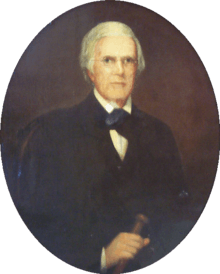Joseph Thorpe Elliston
Joseph Thorpe Elliston (1779 - November 10, 1856) was an American silversmith, planter and politician. He served as the fourth mayor of Nashville, Tennessee from 1814 to 1817. He owned land in mid-town Nashville, on parts of modern-day Centennial Park, Vanderbilt University, and adjacent West End Park.
Joseph Thorpe Elliston | |
|---|---|
 Portrait of Elliston by Washington Bogart Cooper, circa 1840 | |
| Born | 1779 Culpeper, Virginia, U.S. |
| Died | November 10, 1856 Nashville, Tennessee, U.S. |
| Resting place | Mount Olivet Cemetery |
| Occupation | Silversmith, planter, politician |
| Spouse(s) | Louisa Mullen Elliston Elizabeth Odom Blackman |
| Children | 2 sons (including William R. Elliston), 3 daughters |
| Relatives | Alexander Little Page Green (son-in-law) |
Early life
Elliston was born in 1779 in Culpeper, Virginia.[1][2] He moved to Lexington, Kentucky, where he was trained as a silversmith by Samuel Ayers from 1795 to 1798,[2] when he moved to Nashville, Tennessee.[3]
Career
Elliston began his career as a silversmith in Nashville in 1798.[1] He was the owner of a store on the corner of Union Street and 2nd Avenue in modern-day Downtown Nashville, which he ran with his nephew, also called John Elliston.[1] The store burnt down in March 1814, but he opened a new one shortly after.[1] He designed cutlery for President Andrew Jackson, which later became part of the collection of The Hermitage.[1] He also designed jewelry with silver and gold.[1]
In 1811, Elliston purchased 208 acres for $11,435.75 in mid-town, from "what is now 20th Avenue to a line covering part of Centennial Park, and from a line well within the Vanderbilt campus today to Charlotte Avenue."[1] He subsequently purchased 350 acres "along what is now Murphey Road, including the Acklen Park [West End Park] area."[1] It ran across West End Avenue, which had not yet been built.[3] Elliston built a small house, and he named it Burlington "after the Elliston homestead in Kentucky."[4] The house stood on modern-day Elliston Place.[5][6]
Elliston as a city alderman from 1806 to 1814.[1] He served as the fourth mayor of Nashville from 1814 to 1817.[2] He also served on the committee for the construction of the Tennessee State Capitol,[3] and he was a co-founder of the Nashville Female Academy and the McKendree Methodist Church.[1][2]
Personal life, death and legacy
Elliston married Louisa Mullen on August 20, 1800. They had two sons, William and Joseph, and three daughters, Jane, Harriet and Adeline.[7] She predeceased him in 1816,[8] and Elliston married Elizabeth Odom,[7] widow of Charles Elliott and Rev. Learner Blackman.[9] They resided on Sixth Avenue in Downtown Nashville, where the Tennessee Performing Arts Center was later built.[1] His son-in-law, Alexander Little Page Green, was a Methodist minister.[1]
Elliston died on November 10, 1856 in Nashville.[2][8] His funeral was conducted by John Berry McFerrin at the McKendree United Methodist Church.[8] He was first buried in the Nashville City Cemetery and later in the Mount Olivet Cemetery.[2]
Elliston's son William R. Elliston married Elizabeth Boddie, a granddaughter of his stepmother,[7] inherited the Burlington plantation, and served as a member of the Tennessee House of Representatives. Elliston's portrait, done by Washington Bogart Cooper, is in the Nashville Public Library.[2]
Further reading
- Caldwell, Benjamin Hubbard (1988). Tennessee Silversmiths. Winston-Salem, N.C.: Museum of Early Southern Decorative Arts. ISBN 9780945578017. OCLC 837245410.
References
- Davis, Louise (August 14, 1983). "Early Silversmiths Left Marks on City. Names of Elliston, Calhoun Figure Big in Nashville History". The Tennessean. pp. 93–94. Retrieved April 14, 2018 – via Newspapers.com.
- "Elliston, Joseph Thorp (1779-1856)". Tennessee Portrait Project. National Society of Colonial Dames of America in Tennessee. Retrieved April 5, 2018.
- "Staid Elliston Place May Lose Identity". The Tennessean. March 29, 1958. pp. 1, 5. Retrieved April 5, 2018 – via Newspapers.com.
- Thompson, E. D. (March 2, 2016). "The Elliston Family still serves Our Area". The News. Retrieved April 4, 2018.
- Whitsitt Edwards, Amelia (1999). Nashville Interiors, 1866 to 1922. Charleston, South Carolina: Arcadia Publishing. pp. 27–32. ISBN 9780738502205. OCLC 44274945.
- Cason, Albert (June 25, 1981). "Mansion Purchased, Opening Way to Luxury Homes". The Tennessean. pp. 1, 5. Retrieved April 4, 2018 – via Newspapers.com.
- Thomas, Jane H. (1897). Old Days in Nashville, Tenn. Reminiscences. Nashville, Tennessee: Publishing House Methodist Episcopal Church, South. pp. 27–28. OCLC 1011667441 – via Internet Archive.
- "Mayors of Nashville. Not Buried at City Cemetery: Joseph Thorpe Elliston. Term 1813-1817. 4th Mayor" (PDF). Nashville City Cemetery. Retrieved April 5, 2018.
- Sleepy Hill; et al. (October 8, 2012). "Elizabeth Odom Elliston". Find a Grave. Retrieved June 28, 2019.
External links
- Joseph Thorpe Elliston on Find A Grave
| Political offices | ||
|---|---|---|
| Preceded by William Tait |
Mayor of Nashville, Tennessee 1814–1817 |
Succeeded by Stephen Cantrell, Jr. |
